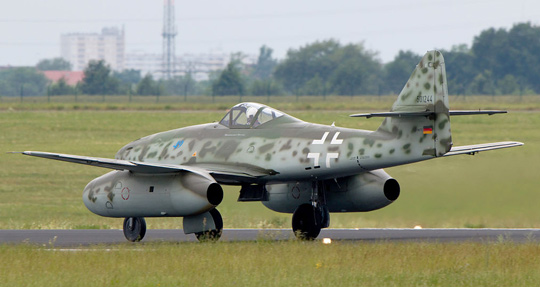|

Me 262 B-1a (replica)
[Photo by
Matthias Kabel, used with permission via Creative Commons]
History: In the pre-nuclear,
pre-terrorist days of warfare, when many battling nations were technological equals,
overwhelming mass was an irresistible determiner of outcome. For a single nation to twice
take on the modern world within a 20-year period, there must be a high level of
self-delusion, if not madness, in the highest ranks of government, especially when it was
still staggering from the effects of losing the first try. None-the-less, Nazi Germany did
exactly that, and no amount of technological ingenuity could alter that fact, as the
history of the Messerschmitt Me 262, the first turbojet to be used in combat, dramatically
illustrates. Had the aircraft been introduced in large numbers in 1939, it is conceivable
that the "Battle of Britain" might have ended as Hitler envisioned, while the
United States, had it become involved, would have had to fight an aerial war from across
the Atlantic, and every pub in England would today be known as "die Bierstube."
Perhaps.
In fact, the Me 262 began as a preliminary design in 1939, without the engines needed to
make it fly. Thus, the first prototype flew in 1941 with a 700hp Jumo 210G piston engine,
and not the planned BMW 003 turbojet engines.
The early prototypes were fitted with conventional tail wheels. However, this
configuration made takeoffs highly dangerous, so a fully retractable tricycle landing gear
modification became the standard. The Me 262A-1a "Schwalbe"
("Swallow") was the first production model of the Me 262. It was produced with
four Mk 108 30mm cannon mounted in the nose, in its role as an interceptor, a role that it
performed with great promise except for several limiting factors: First, it came into the
battle far too late, when the Allied air forces had reached formidable capacity; secondly,
its engines were a constant source of trouble, frequently failing after no more than 12
hours; third, it was utilized inappropriately for far too long, after Hitler decided that
the machine should be used in a bombing capacity, to "punish" the Allies. That
version, the Me 262A-2a "Sturmvogel"
("Stormbird") was reconfigured to carry two 550lb bombs, still retaining the
four cannon. A further refinement, Me 262A-2a/U1 had two of the
cannon removed to provide space for a bomb-aiming device, and Me 262A-2/U2
carried a prone bombardier in the nose section. Thus, for much of the aircraft's brief
combat life, it was used against the wrong type of targets, with even less effect than if
it had been used as an interceptor.
In addition to bomber, ground attack and night fighter variants, the Me 262 was also
produced as a tandem two-seat trainer, the Me 262B-1a. Four
262A-1as were modified to carry a single 50mm Mk 214 cannon which extended almost 7 feet
beyond the nose of the plane, but the blinding flash from the barrel limited the
effectiveness of the device. In any case, it didn't matter. There were 1,433 Me 262s
built, with nearly 500 more destroyed by bombing raids before they were completed. Of that
total, fewer than 300 were actually used in combat.
Using equipment and components manufactured during the occupation of
Czechoslovakia, some Me 262s were produced by Avia, in Czechoslovakia after the war, under
the designation S.92.
In its brightest moments, when it was used as intended, the Me 262 was the equivalent of
sending the "Three Musketeers" against Sitting Bull at Little Big Horn. In one
battle, for instance, 37 of the 262s were scrambled against an Allied raid that consisted
of 1,221 bombers and 632 fighter escorts! In their most effective performance, they cost
the Allies a one percent loss.
Despite the fact that the Me 262 is one of the
most rare and esoteric aircraft of World War II, at least one group has endeavored to
build brand new copies of this interesting airplane, updated to modern safety standards,
and powered by more modern jet engines. The distinctive profile of the Me 262 has recently
graced the skies again, this time in peaceful reflection rather than with hostile
intent.
Nicknames: Turbo (Used by German
pilots.)
Specifications (Me 262A-1a):
Engines: Two 1,984-pound thrust Junkers Jumo 004B-1/-2/-3 turbojets (Modern replicas to be
powered by General Electric J85 axial-flow turbojets).
Weight: Empty 8,378 lbs., Max
Takeoff 14,110 lbs.
Wing Span: 40ft. 11.5in.
Length: 34ft. 9.5in.
Height: 12ft. 7in.
Performance:
Maximum Speed:
540 mph
Ceiling: 37,565
ft.
Range: 652 miles
Armament: Four 30-mm MK 108 cannon in
nose
Number Built: 1,433
Number Still Airworthy:
Three
replicas.
Links:
Air Assets International,
Colorado, USA -- Brokers for new Me-262 replicas.
Classic Fighter Industries, Inc.
Me-262 "Stormbirds" Site

[ Click for more books
about the Me 262! ]

[Back to Warbird Alley's Main
Page]
All text and photos Copyright 2016 The
Doublestar Group, unless otherwise noted.
You may use this page for your own, non-commercial reference purposes only.
 |